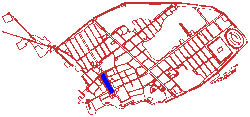
|
Everything seen in this picture was once buried and will likely be buried by Vesuvius again some day. The large open area in the center is the Forum. To the left is the Temple of Apollo. Below that is the Basilica. The large grassy area to the right of the Forum is the Building of Eumachia.
As early as the end of the second century, the Roman government had men digging at Pompeii to retrieve large public statues from the forum and to remove building materials for other towns. The salvage work had to be curtailed while Vesuvius violently erupted for seven days in 203 A.D. By 1700 there were only a few scholars who knew that Pompeii had ever existed. There was no one living who knew the location of the lost Roman cities of Campania. While digging his well deeper in 1711, a landowner discovered fragments of ancient marble which eventually came to the attention of the Austrian aristocracy in Naples. Miners began to tunnel horizontally from the bottom of the well and began finding marble statues of exquisite detail. Tunnels destroyed irreparably many works of art on the walls of various buildings. The excavations were abandoned until 1738 when treasure hunters, under commission of King Charles of Bourbon, then ruler of Naples, discovered an inscription which identified the site as that of the lost town of Herculaneum (known today in Italy as Ercolano). The science of archeology did not yet exist and little effort was made to do anything more than retrieve lost classical works which could be added to royal palaces. King Charles wanted to keep the discoveries a secret until he had amassed enough ancient treasures that Naples could become a center of art that would rival Florence. But in 1740 Horace Walpole, the son of the British Prime Minister, visited the area and wrote back to England that an underground Roman town was being recklessly explored. As the digging at Ercolano became more trouble than productive, men began to search for other cities buried by Vesuvius during Roman times. Pompeii was found in 1748, but because few statues and frescoes were unearthed, the site was reburied and forgotten until it was correctly identified as Pompeii in 1763. These ancient ruins began to offer the world an insight into the art and life of the Roman Empire. The birth of the Neoclassical movement in art and architecture is largely the result of Western civilization's fascination with new discoveries around Vesuvius. The style of buildings in Washington, D.C., would be different if Pompeii and other nearby buried cities and villas had not come to light in the eighteenth century. |

